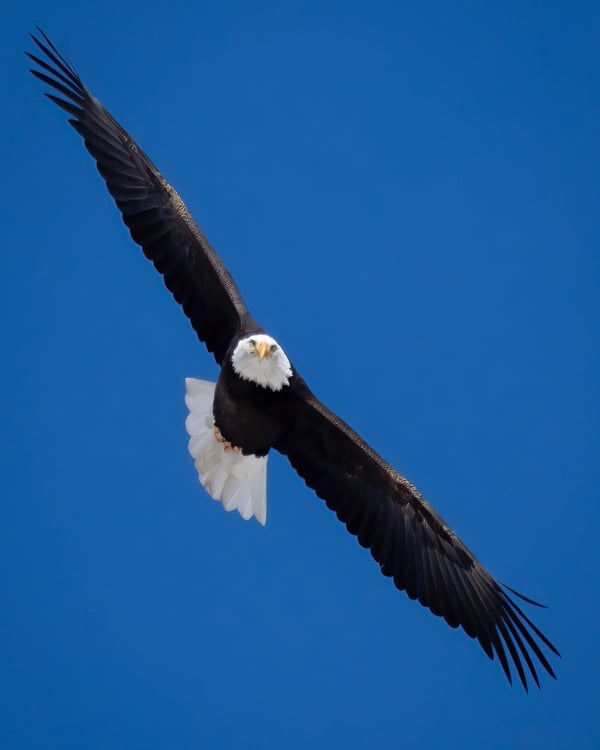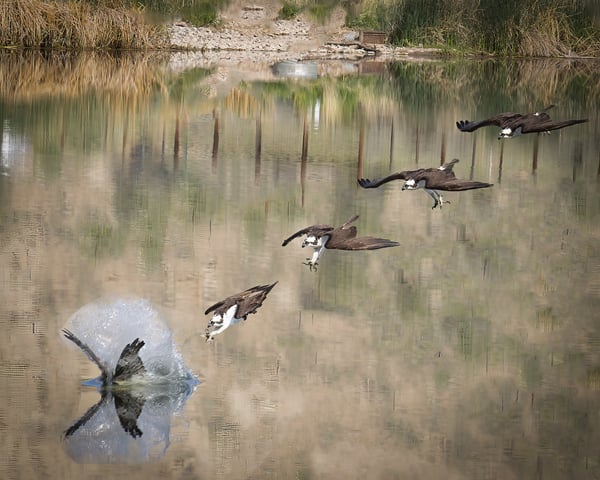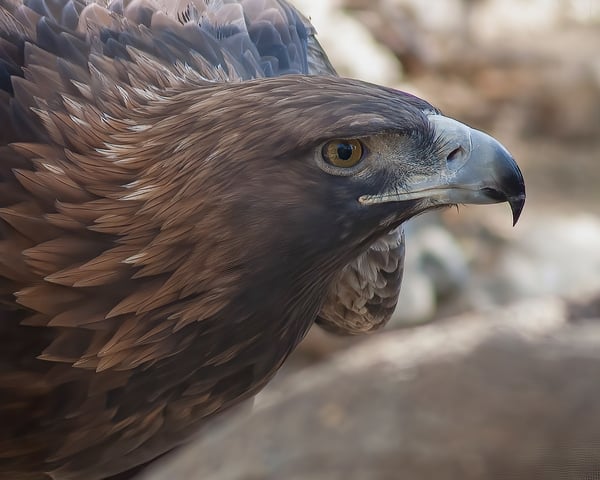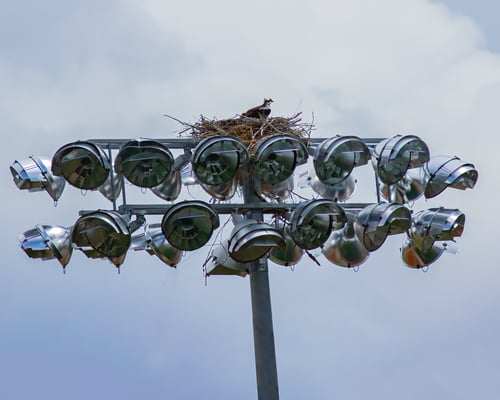Text and Photos by Rick Spitzer,
For the Eagle County Wildlife Roundtable
Humans have had a reverence for raptors since the beginning of time. Native Americans took note of the majestic appearance of raptors and admired their hunting skills. Many Native Americans used talons and feathers for ornamentation. That reverence carries over to today. Most people probably get more excited about seeing a raptor than any other bird.
As a group, raptors are birds of prey, they consume other animals. That statement does not define them because many other kinds of bird consume animals. Think storks, herons, gulls, penguins and many insectivorous songbirds.
Raptors have three distinctive characteristics. Their most important tool is the sharp talons on their feet. They are used for grasping, killing, and holding prey. Raptors also have hooked upper beaks for tearing flesh. In addition, raptors have the keenest vision of any vertebrates and that allows them to locate and capture prey. Some raptors hunt for food, but others only consume carrion, dead animals.
The hooked beak of raptors is used to tear meat.
Birds have some of the longest migrations of any animal on the planet. As they travel, they are dependent on food resources and quality habitat to survive that trip. The bird’s habitats are changing. Forest fires, pollution, human disturbances, industrial contamination, hunting, light pollution, and others may impact available food and places to rest as they make their journey. Climate change is impacting the bird’s range with areas of drought, lower water levels, higher temperatures, seasons that start earlier, more severe weather and weather with greater severity.
Even when the birds arrive at their destinations, they may face any or all these issues in their summer or winter habitats. A false spring with unseasonably warm, mid-winter days “trick” plants into flowering early. When the birds arrive, foods they depend on, nectar or seeds, may no longer be available which may force birds to abandon their normal range to find suitable habitat.
It is vital that we stabilize carbon emissions to hold down warming to 1.5°C above pre-industrial levels. Colorado does have an action plan to reduce greenhouse-gas pollution. Many cities and some utilities aim for 100-percent zero-carbon electricity by 2050. We all need to step up.

The bald eagle, our nations symbol, effortlessly soars on thermals in many areas of the county.
Locally the birds of prey belong to these groups.
• Accipitridae: hawks, eagles, harriers.
• Pandionidae: osprey
• Falconidae: falcons
• Cathartidae: vultures
• Strigiformes: owls
In Latin the word "raptor" means “to carry away.” We often are awe struck when we see a raptor swoop down, pick up a rodent or fish and fly away.
That alone makes it a worthy cause to protect these birds. But, there are a number of things that can impact the health of raptors.
Raptors fill an important niche in our ecosystems. Raptors are at the top of food chains and help to maintain a balance in the populations of rodents, rabbits, fish, amphibians, and reptiles.
Scientists monitor raptor populations carefully. An increasing population of raptors within an ecosystem is an ecological indicator that some species population is too high. A decreasing population may point to other issues. What might cause a raptor population to decline?

Osprey capture fish by diving into ponds feet first using their talons to grab the fish.
Poisoning
Raptors help us gauge how healthy a habitat is. Birds of prey tend to be sensitive to small environmental changes. Their health often is impacted by pesticides and other chemicals that may increase in our environment. The use of these chemicals was challenged by Rachel Carson in her ground-breaking book "Silent Spring," that was published in 1962. Many people consider the modern environmental movement started because of that book.
At that time the peregrine falcon, our national symbol the bald eagle, and many other birds were severely impacted by a potent insecticide called DDT (dichlorodiphenyltrichloroethane). The insecticide was applied to control insect populations. DDT slowly accumulated and became more concentrated in animals in each stage of the food chain. When a bird began to accumulate the poison, it altered the bird's calcium metabolism and that resulted in thin eggshells. Those eggs were unable to support the weight of the incubating bird and the result was a crash in the populations of many birds.
The breeding failures were identified as being caused by using DDT. DDT was banned almost totally in the United States in 1972 and the bird population started making a recovery.
Using a pesticide or poison to kill rodents or other nuisance animals can also be harmful to raptors. The pesticides applied to golf courses, and pastures kills the rodents, and the dead rodents are eaten by raptors. The buildup of the pesticide or poison may kill the raptor or their young. In some places the carcass of an animal is laced with a poison intended for wolves or coyotes that would scavenge on the carcass. Raptors may also feed on those carcasses which results in the death of the raptor.
Another type of poisoning comes from lead. Lead sinkers (used by fisherman) may be swallowed by a fish, and the fish is eaten by an Osprey or Bald Eagle. Also, hunters use lead ammunition hunting waterfowl. As raptors feed on waterfowl carcasses that contain lead, they ingest the lead and may be poisoned.

This red-tailed hawk feeds on a marmot carcass on the side of the road, a spot where collisions with cars is possible.
Tolerance for People
Different types of raptors have a different tolerance for people around their nests. Some raptors seem to have little concern about people around them. A red-tailed hawk nest on a local golf course fledged several young over several years with golf carts on the path directly below the nest. There are osprey nests that have been occupied for years on the center light poles at several baseball fields in Eagle County.
Some bald eagle nests along the Eagle River show no concern with fisherman in the river and rafters floating by. Another nest I frequently observed had a class of grade school kids walk up to the base of the tree with the nest. That caused the two adults to fly away. The adults did not return in the days after that event and the nest has not been occupied since.
It can be difficult to define what constitutes a disturbance and different pairs of birds may respond differently. The Colorado Parks and Wildlife has some guidelines to limit encroachment that were developed in 2002 and revised in 2008. Those guidelines help to define the limits of surface occupancy, beyond that which historically occurred in the area, for active nests of different raptor species. There are different limits from within 1/4 mile radius to ½ mile of active nests.
Raptors are often killed when they hit fence wires or power lines while pursuing prey.
Collisions
Many birds are killed due to collisions with manmade structures. Powerlines, high tension lines, and wire fences may be hard to see by fast flying birds focused on their prey. Birds may collide with buildings, windows, and windmills. Many raptors collide with cars while in flight or when they stop to feed on road kills.
Electrocution
Raptors will often perch on power and utility poles. They make a great place to rest or to spot prey. However, most raptors have large wing spans and a bird that lands or takes off may touch the wire and a grounding spot on the pole and be electrocuted. Power companies have developed structures that prevent the birds from landing, or they insulate the wires. Some companies have erected poles near powerlines that are designed for perching or nest building to keep the birds away from the hazards.
Habitat Loss
Probably the greatest impact on raptor populations has to do with habitat loss. Housing, parking lots, and roads cover over fields that may have provided food sources for many raptors. Rivers and lakes may have pollutants from residential and industrial sites that eliminate food sources or even poison the birds.
Deforestation causes a loss of nesting sites for many raptors. Agriculture also replaces the native habitat with crops. Those areas are removed from use of the raptors since it eliminates the prey that the birds depend on.
Climate Change
Climate change is impacting the temperatures in vast regions. Spring is coming earlier, and fall is lasting longer. There is also an increase in temperature. Those things are changing the way that plants develop. Plants begin growing earlier and produce flowers or seeds earlier and, in some cases, later. This changes the behavior and mating seasons for many animals that are prey for raptors. Those that migrate may find a change in the food supply they depend on.
The rough-legged hawks breed in open country of the arctic in the summer. They migrate south in the fall to winter in this area. How will the food supply change for the hawks? Some species are not traveling as far south in their migrations. How might that change the prey species if the hawks no longer come this far south or go farther north?
Increased temperatures are also increasing the number and variety of insect pests that create problems for raptors. They bite the young in the nests and make the life of chicks miserable. Some are not surviving these events.
Nearly every ball field in Eagle County has an Osprey nest on one of the light poles.
What Can We Do?
We all enjoy the birds of prey. Watching a bald eagle soar on thermals with little or no effort is amazing to watch. Seeing an osprey dive into a lake to catch a fish has the same impact. Hearing an owl in the night sends our minds to other places. All these things are a part of nature that we all enjoy and wish to keep in our lives.
We should look to alternatives for any activity we do that might have an impact on these birds. Do not use chemicals, especially outdoors. This minimizes direct poisoning as well as what goes into streams and rivers. Be cautious about how chemicals are being used. The same is true for lead, use alternatives to avoid harming raptors. Think about our impact on the land. Be aware of how our actions as nature lovers, birders, or photographers might disturb raptor nests and maintain a safe distance. As with all wildlife, if their behavior changes as a result of our presence, we're too close. Reduce our carbon emissions, consider electric appliances and cars where possible, solar roof panels are also beneficial. Let your elected officials know it's important to preserve open space habitat so raptors have prey to survive. Consider conservation easements if you own acreage. Join us in doing everything we can to keep these majestic birds thriving for future generations to enjoy.
======================================
The Eagle County Community Wildlife Roundtable is a collaborative partnership with the White River National Forest, Colorado Parks and Wildlife, Bureau of Land Management, local government entities, community members, and citizen scientists. The purpose of the Eagle County Community Wildlife Roundtable is to gather a group of diverse stakeholders in the valley to understand and address issues facing wildlife populations. Together we will identify a shared vision and realistic actions that the community can rally around to support wildlife. We want to leverage diverse values, creativity, and resources to move toward positive action.
======================================






.jpg?width=500&height=625&name=image005%20(1).jpg)





